Impact of Microbial Application on Growth & Development of Dalbergia latifolia & Dalbergia sissoo under Nursery Condition
Soumya Ranjan Nayak, Manas Ranjan Panigrahi and Nibha Gupta*
Plant Pathology and Microbiology Division, Regional Plant Resource Centre, India
Submission: April 29, 2017; Published: May 25, 2017
*Corresponding author: Nibha Gupta, Plant Pathology and Microbiology Division, Regional Plant Resource Centre, Bhubaneswar -751015 Odisha, India, Email: nguc2003@yahoo.co.in
How to cite this article: Soumya R N, Manas R P, Nibha G .Impact of Microbial Application on Growth & Development of Dalbergia latifolia & Dalbergia under Nursery Condition. Int J Environ Sci Nat Res. 2017;2(4): 555592. DOI: 10.19080/IJESNR.2017.02.555592
Abstract
In the present study, a pot culture experiment was carryout on Dalbergia latifolia (Roxb) and Dalbergia sissoo for which 30 days old seedlings were developed from freshly collected seeds and subsequently supplemented with previously screened 2 phosphate solubilizing fungi and 2 Rhizobacterial broths of 7 days old, individually as well as in combination. The experimented plants were inoculated for 120 days at 30 days interval. Data recorded for plant height, biomass, leaf area, leaf no., branch no. and other physiological growth parameters RGR, NAR, LAR, QI and R/S. Growth analysis revealed that, Aspergillus niger and Co-inocuation of selected microbes may be useful for successful establishment of D. latifolia & D. sissoo in nursery condition and help in producing quality planting materials.
Keywords: D. latifolia; D. sissoo; Phosphate solubilizing fungi; Rhizobium; Growth parameters
Introduction
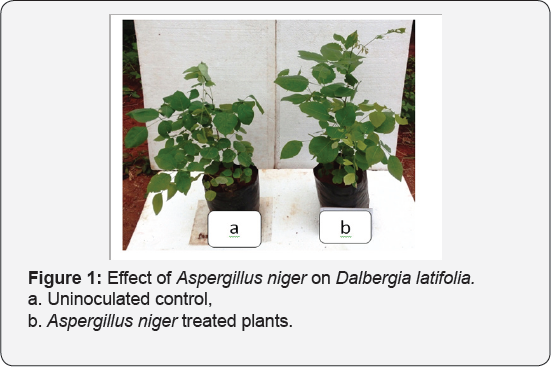
The forest tree species belonging to Dalbergia are important timber trees, valued for their decorative and often fragrant wood, rich in aromatic oils Thurlough et al. [1], Vasudeva et al. [2] Dalbergia latifolia (Roxb) Family-Fabaceae, a large glabrous tree a single stem with characteristic smells, grey bark, thin with irregular short cracks, exfoliating in fibrous longitudinal flakes Parrota [3], Troup [4]. It is distributed in Bihar, Bundelkhand and Central India (Figure 1). Quality of having a long cylindrical bole, high strength and high density. The high quality wood properties make this species highly valuable and great demand. Hence, facing problem of depletion in population Raghava Swami et al. [5]. Besides wood demand it has great medicinal properties due to tannin which is being used for leprosy and worm Kirtikar & Basu [6]. It is slowing growing and prone to jungle fire which also promotes its depletion in the natural forest. Hence, prioritization of large scale production and plantation is required Sujatha et al. [7].
Dalbergia sisso is important plantation tree species and useful for afforestation program due to excellent coppicing properties. This species is endowed with many medicinal properties Ahmad et al. [8]. Hence, its large scale propagation & plantation is needed for the point of huge demand as well as environmental concern. Soil is composite system and inherent with many microbes including bacteria and fungi. Their population depends upon all multifarious condition also. Most of the tropical soil are "P" fixing and do not make available. This mineral content to the medicinal plant. Hence an additional dosage of P' is require to fulfill the plant demand. To save the cost of chemical fertilizers as well to get rid of its ill effect over plant health, an alternative as bio-fertilizer is required. Many fungi and bacteria are reported to have capability to solubilize the bonded form of P' content White law [9]. It may happen due to secondary metabolites and for enzymes Holford (1997). The application of such types of organism either alone or in combination with the other useful organism especially nitrogen fixing make a suitable and worthy combination to help plants for microbial leaching and subsequent uptake Lee & Bressan [10]; Chen et al. [11].
In the present study, both the legume tree species are (one) facing problem of slow growth (D. latifolia) and (second) high demand (D. sissoo) were taken into consideration to develop a nursery technology so that a quality planting material could obtain. Quality material of any tree species will certainly be useful for the large scale plantation program which can save fertility and produce healthy plant products and fulfill the demand.
Materials and Methods
Present experiment was carried out during April-August, 2016 in the experimental field of Regional Plant Resource Centre, Bhubaneswar, Odisha, India. The experiment was done in poly bags containing 5.5 kg red soil. Pot soil was fumigated with 1% formalin for 48 hrs prior to the experiment. Deep brown colored flat seeds were decapsulated and sown in presaturated poly bags. Seeds were germinated in the poly bags. Two Rhizobium and two phosphate solubilisng fungal isolates (confirmed earlier through plate culture test performed on Pikovskaya' medium) identified as Aspergillus kanagawaensis, Aspergillus niger were supplemented into the experimented plants, individually and combination of both. The seven day old culture developed in Sabouraud Dextrose broth and Nutrient broth at 30°C were inoculated (@ 100 ml /poly pot ) separately & thrice with monthly interval.
Un-inoculated plants were considered as control and regular watering was done to keep the plants healthy. Final data was recorded on 120th day for Plant height, fresh and dry biomass, root shoot ratio, physiological growth parameter like Relative Growth Rate (mg g-1 d-1), Leaf Area Ratio (cm2 g-1), Net Assimilation Rate (mg cm-2 d-1), Quality Index, were calculated Dori et al. [12], Basak et al. [13], Leopold & Kriedemann [14], Noggle & Fritz [15], Tewari et al. [16] and Dickson et al. [17]. Root Shoot ratio was calculated by using the formula root length (cm)/ shoot height (cm). The raw data was further used to calculate the average and standard deviation for all parameters were calculated.
Results and Discussion
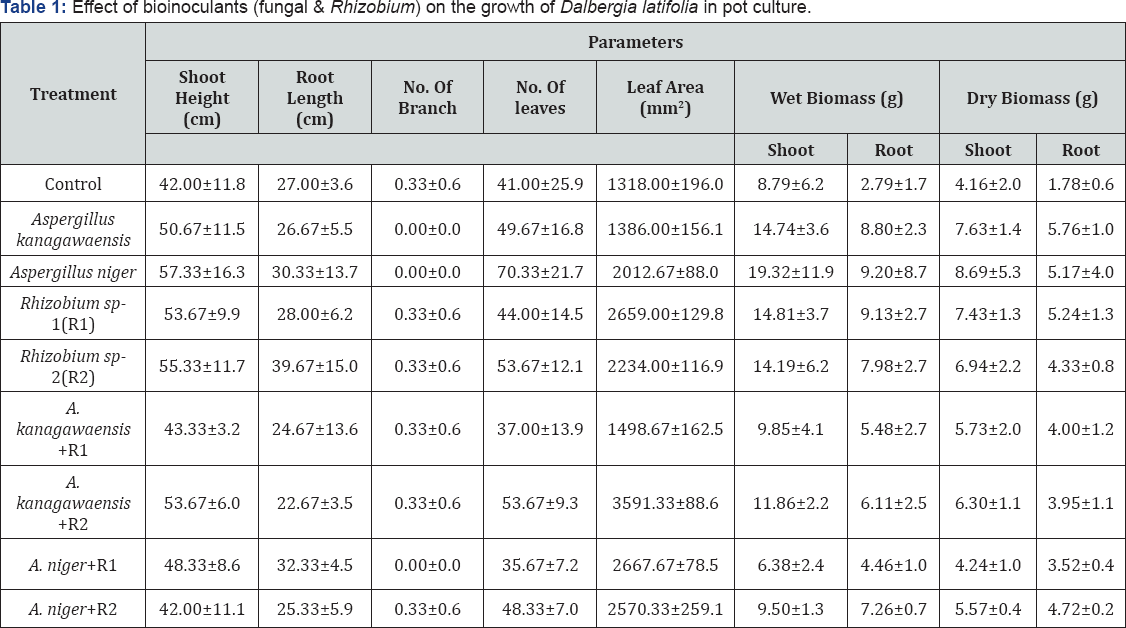
Significant Increase in growth parameters of D. sissoo and D. latifolia seedlings over uninoculated control was indicative of the potential effect of these inoculants. Aspergillus niger is observed to be effective inoculants for D. latifolia influencing the shoot height (57.33±16.3cm), dry biomass (8.69±5.3 g), no. of leaves (70.33±21.7) (Table 1), RGR (0.061d-1) & LAR (0.58 m2.g-1) (Table 2). Aspergillus kanagawaensis showed significant difference in leaf area (3591.33±88.6 mm2), dry biomass of root (5.76±1.0 g) and Quality index (0.258) (Tables 1 & 2) in D. latifolia. Rhizobium sp.-2 inoculated D. latifolia shows highest root length (39.67±15.0cm) and root shoot ratio (0.72) (Figure 2). The combination of Rhizobium sp.-2 and Aspergillus kanagawaensis in equal proportions was the most effective inoculants for NAR (0.10 g.m-2.d-1) (Table 2) in D. latifolia.
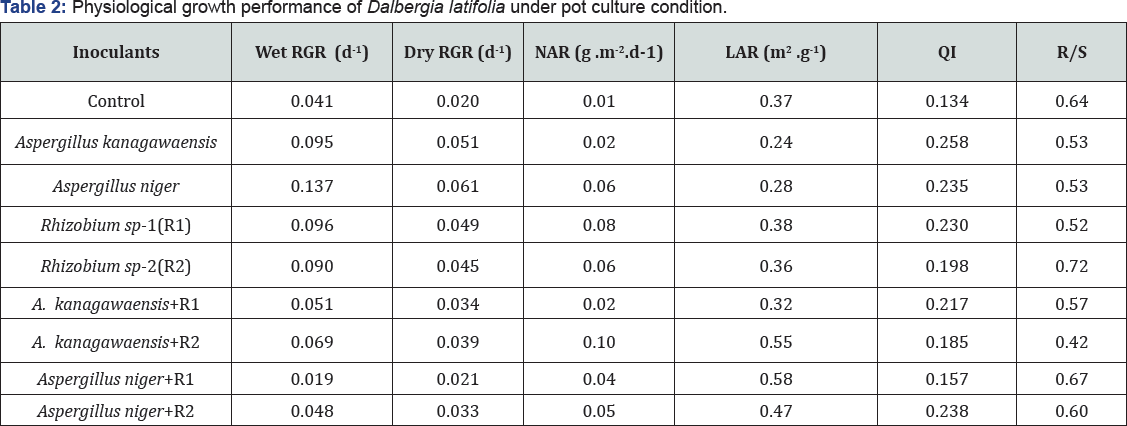
Where, RGR: Relative Growth Rate; NAR: Net Assimilation Rate; LAR: Leaf Area Ratio; QI: Quality Index; R/S= Root Shoot Ratio.

Similarly, in D. sissoo, Aspergillus niger was effective for the shoot height (94.33±8.5cm), Rhizobium sp.-1, was momentous in root length (29.67±3.1cm) (Table 3), NAR (0.05 g.m-2.d-1) and R/S (0.35) (Table 4). Rhizobium sp.-2 supplemented plantlets showed highest no of branch (4.67±0.6), dry shoot biomass (8.58±1.2g) & RGR (0.060d-1). Aspergillus niger co-inoculated with Rhizobium sp.-1&2 were found to be responsible for no of leaves (4.67±0.6) and Quality index (0.129) respectively. Combination of A. kanagawaensis and Rhizobium sp.-2 resulted in highest leaf area (1741.33±35.8 mm2) and LAR (0.30 m2.g-1) (Tables 3 & 4).
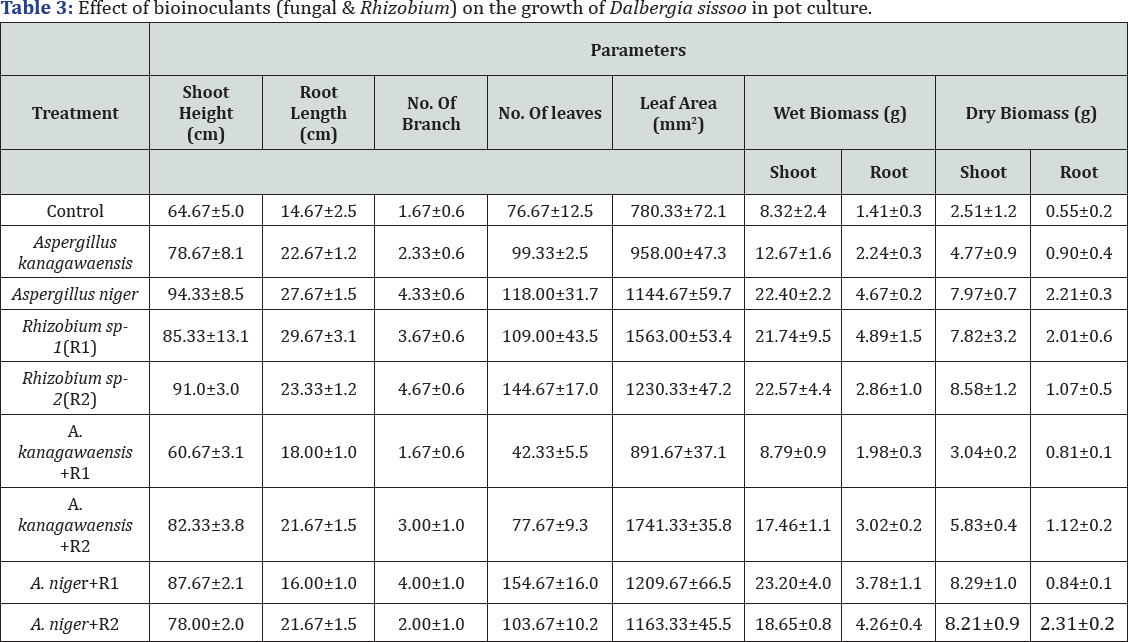

Where, RGR: Relative Growth Rate; NAR: Net Assimilation Rate; LAR: Leaf Area Ratio; QI: Quality Index; R/S: Root Shoot Ratio.
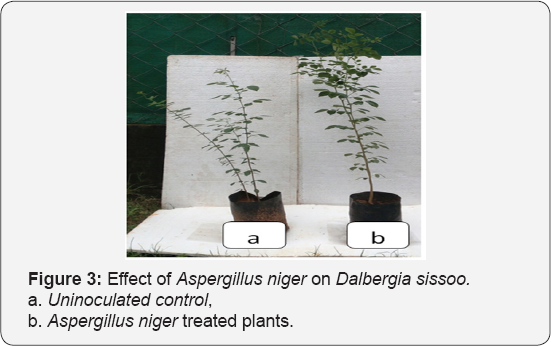
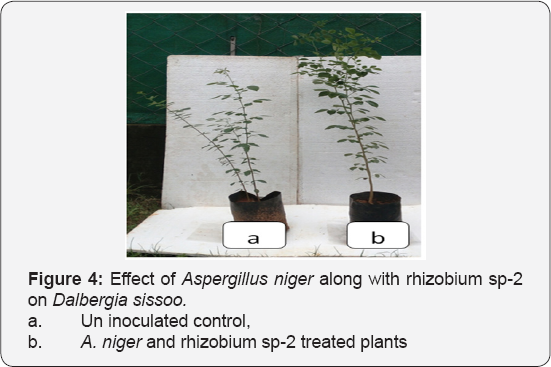
In present ex periment to evaluate the effective plant growth promoting ability of phosphate solubilizing fungi on forest trees was set up on Dalbergia sissoo & Dalbergia latifolia in pot culture condition which was supplemented with liquid cultures of phosphate solubilising fungi namely: Aspergillus kanagawaensis, Aspergillus niger and two Rhizobium sp-1 & 2 (Figure 3). The different fungal strains used in the present study were having phosphate solubilising potential tested in plate culture method in laboratory earlier. Previously, Odee et al. [18] recommended inoculation of liquid cultures for the healthy seedlings in the nursery conditions. This also helps in increasing fungal population in the rhizosphere and finally mineral solubilisation (Figure 4). In the present experiment revealed the effect of fungal and Rhizobium inoculation and their usefulness as bioinoculants for plant productivity. In present study Aspergillus niger indivisually and combined with Rhizobium sp.- 2 found to be most effective for overall plant growth promotion and establishment in both the experimented plants.
Conclusion
This experiment illustrates that the co-inoculation of A. niger and Rhizobium has improved nutrient status of the rhizospheric region. This combination brought about significant increase in the growth parameters of Dalbergia plants, suggesting their application for better growth and establishment.
Conclusion
Authors acknowledge the financial assistance obtained from Forest and Environment Dept., Govt. of Odisha through State Plan project 2015-16.
References
- Thurlough O, Criodain MOS, Mary JM, Dervilla MXD (2001) Latinone, a phenanthrene-1, 4-quinone from Dalbergia latifolia. 20(5): 10891092.
- Vasudeva N, Vats M, Sharma SK, Sardana S (2009) Chemistry and biological activities of the genus Dalbergia - A review. Pharmacognosy Review 3(6): 307-319.
- Parrotta JA (2001) Healing Plants of Peninsular India. CABI publishing, Wallingford, UK.
- Troup, Robert Scott (1991) The silviculture of Indian trees. Oxford, Clarendon Press, UK.
- Raghava Swamy BV, Himabindu K, Lakshmi Sita G (1992) In vitro micro propagation of elite rosewood (Dalbergia latifolia Roxb.) Plant Cell Reports 11(3): 126-131.
- Kirtikar KR, Basu BD (2005) Indian medicinal plants. International Book Distributor, Dehradun, India.
- Sujatha MP, Thomas P, Thomas, Maria Florence EJ (2008) Growth Enhancement of Dalbergia latifolia through soil management techniques. KFRI Research Report No 303, Kerala, India, pp. 1-110.
- Ahmad K, Khan ZI, Ashraf M, Hussain M, Valeem EE (2009) Levels of Total Amino Acids, Soluble Proteins and Phenolic Compounds in Forages in Relation to Requirments of Ruminants Grazing in the Salt Range (Punjab), Pakistan. Pakistan Journal of Botany 41(3): 15211526.
- Whitelaw MA (1999) Growth promotion of plants inoculated with phosphate solubilizing fungi. Advances in Agronomy 69: 99-151.
- Lee TSG, Bressan EA (2005) Clean cane with nitrogen fixing bacteria. Sugar Tech 7(1): 11-16.
- Chen YP, Rekha PD, Arun AB, Shen FT, Lai WA, et al. (2006) Phosphate solubilizing bacteria from subtropical soil and their tricalcium phosphate solubilizing abilities. App Soil Ecol 34(1): 33-41.
- Dori S, Solel Z, Kashman Y, Barash I (1990) Characterization of hydroxamate siderophores and siderophore mediated iron uptake in Gaeumannomyces graminis var. tritici. Physiological and Molecular Plant Pathology 37(2): 97-106.
- Basak UC, Gupta N, Rautaray S, Das P (2004) Effects of salinity on the growth of mangrove seedlings. Journal of Tropical Forest Science 16(4): 437- 439. This work is licensed under Creative Commons Attribution 4.0 Licens DOI: 10.19080/IJESNR.2017.02.555592
- Leopold AC, Kriedemann PE (1975) Plant Growth and Development. McGraw-Hill Book Co, New York, USA, pp. 466-545.
- Noggle GR, Fritz GJ (1986) Introductory Plant Physiology. Prentice Hall of India Private Ltd, New Delhi, India.
- Tewari P, Saxena AK, Rao OP (2006) Effect of sodicity and salinity on seedling growth of two early successional agro forestry tree species. Tropical Ecology 47(1): 125-132.
- Dickson A, AL Leaf, Hosner JF (1960) Quality appraisal of white spruce and white pine seedling stock in nurseries. Forestry Chronicle 36(1): 10-13.
- Odee DW, Indieka SA, Lesueur D (2002) Evaluation of inoculation procedures for Calliandra calothyrsus Meisn. grown in tree nurseries. Biology and Fertility of Soil 36(2): 124-128.






























